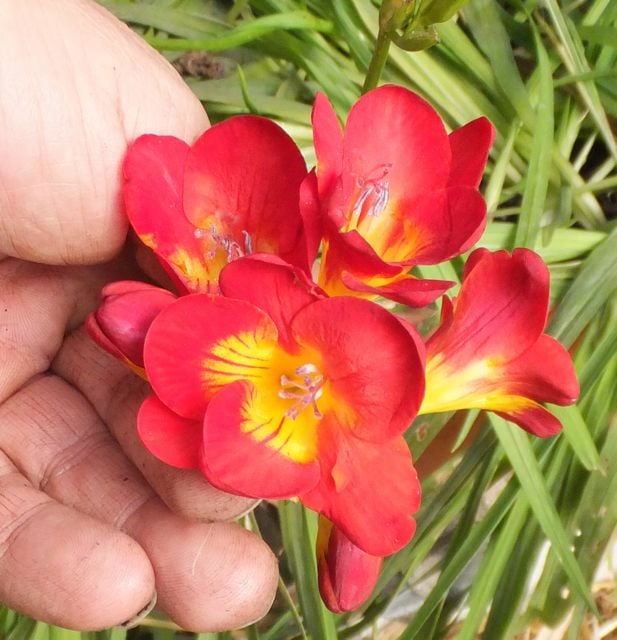 A greenhouse flower that almost everyone knows by name but no-one now grows are Freesias. These are members of the Iris family and never reached Britain until well into Queen Victoria’s reign when they rapidly proved popular. Perhaps because coming from South Africa these were one of the few Cape flowers we discovered there that possess a rich perfume. Or rather I should say possessed for the scent is rather well known to have been lost.
A greenhouse flower that almost everyone knows by name but no-one now grows are Freesias. These are members of the Iris family and never reached Britain until well into Queen Victoria’s reign when they rapidly proved popular. Perhaps because coming from South Africa these were one of the few Cape flowers we discovered there that possess a rich perfume. Or rather I should say possessed for the scent is rather well known to have been lost.
The original Freesia refracta had cream flowers with an orange throat, open funnel shaped somewhat resembling lilies, and with just a few on a stem. Intensive breeding led to pink, then orange, gold and eventually deep red blooms and more of them. Sadly with the increase in pigmentation the scent became lost.
However this trade off was considered worthwhile as the intense colour of modern varieties make them such excellent flowers for cutting. Rather fortunately as their gangly straggly habit also makes them much more suited to growing for cutting than for displaying on the bench in their pots.
Freesias can be grown to bloom the following year from seed sown the beginning of May in deep boxes of well drained compost. This needs to be of low fertility composed of mostly sharp sand and leaf mould. Do not sow deeply but barely cover the seed and keep the compost only just moist by standing in a tray then draining rather than by overhead sprinkling. Indeed Freesias must never be damp, wet, fed, or in the shade, or they simply pine and decay.
None the less otherwise their requirements are simple needing a sunny position with not high temperatures but cool and no more than frost free conditions throughout winter. Once past the New Year and given temperatures of about ten degrees Centigrade / fifty Fahrenheit in a sunny spot, even a windowsill, then the young plants come into bloom providing their bulbs grew large enough. If not they will the next year.
The foliage is typical Iris family but flimsy and the stems thin so these do not properly support the heavier flowerheads we have developed. Thus for nice straight stems for cutting each needs to be tied to a cane or grown with some support. If you don’t mind curly stems and just grow blooms for their beauty then this’s no problem.
After flowering has finished dry off the plants completely so the bulbs can ripen. Then keep them dormant till August when you start them off again. Of course you can buy bulbs to start in August, and if you pot some up every fortnight or so you will then get a succession of flowers in late winter and early spring. There are even bulbs available that have been specially treated which you can buy to plant in spring to flower that summer.
Collectors might look for the old original form and the intensely fragrant dwarf F. andersoniae.










